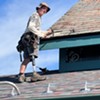Published May 18, 2005 at 4:16 p.m.
Bob Volk nimbly climbs down from a preposterously steep roof near the University of Vermont in Burlington. The house he's working on is more than 100 years old but still has its original slate roof -- or a large portion of it, anyway.
That's one of the advantages of having a roof made of stone slabs: When a section chips or starts to leak, it can be swapped out with new or salvaged slate. In the end, the entire roof is as good as new.
Assuming, that is, you can find someone to do the job. These days, it's easier said than done. Slate roofing is a dying art. Fewer tradespeople are learning it. And since the cost of a slate roof can run two to three times more than a conventional one, fewer homeowners are installing new slate roofs, or preserving ones already in place.
In one respect, that's not surprising. In an era when most homeowners think in terms of a 30-year mortgage -- and the majority of them sell their homes before paying it off -- the idea of investing in a roof that can outlive its owners, their children and grandchildren is foreign. Simply put, most of us don't plan that far into the future.
Volk believes that's a shame. Many of Vermont's historic buildings have gorgeous slate roofs, largely because the material was once inexpensive and readily available throughout New England. The slates' styles and colors often reflect the places they were quarried: Vermont Sea Green, Pennsylvania Black and Peach Bottom Georgian. New York Red is a rare, high-quality slate that isn't quarried much anymore but can be worth thousands of dollars in the salvage market.
Slate roofs were often laid out in intricate patterns to look like flower petals or undulating waves. And, if you look closely at some examples in Vermont, you might notice an odd-colored slate that's been cut into the shape of a heart -- Volk's own stone signature.
Volk, 42, has been slating roofs for 24 years, and has had his own business -- Valley Roofing in Waltham -- since 1986. Years ago, he answered an ad in a newspaper to apprentice with a New Jersey slate roofer named Lutz Rhinelander, an old-school German slater who spoke virtually no English. He taught Volk almost everything he knows.
By its very nature, slate roofing is custom work. Each stone is cut by hand. To demonstrate, Volk pulls a slate hammer from his tool belt. It looks like a cross between a carpenter's hammer and an ice climber's axe, with a blade cut in the elbow notch. You might assume that slate would be incredibly fragile and shatter with one tap of the hammer. Not so. Using quick, chopping motions, Volk deftly carves the friable stone into a curved pattern.
"Working with slate comes so natural to me," he says, hammering out a heart-shaped tile in less than a minute. "I don't know why, but I can't teach anybody else. They just don't seem to catch on."
Though Volk occasionally purchases newly quarried slate for a repair job like this one, more typically he finds high-quality salvaged slate to match the color and size of an existing roof. He affixes the slate -- which must be carried up the ladder one by one or in small stacks -- using an awl-like tool to punch small holes in the top third of each piece. Then he delicately nails them down so the holes of one slate are covered by the piece above it. Volk is meticulous about alignment. After eyeballing the roof from the ground, he may scurry up and down the ladder several times to get the positioning just right.
Volk says he's often surprised by how little many homeowners know about their own slate roofs. Slate is waterproof, fireproof, highly resistant to wind, and incredibly durable to the elements, even after a century or more of harsh Vermont winters. A high-quality slate roof generally looks smooth and shiny, but even soft, chipped or crumbling slate roofs are often worth preserving. And depending upon the type of slate and environmental conditions in the area -- pollution can obscure the slate's original color -- a slate roof can sometimes last more than 200 years.
"I think what's interesting is that they haven't been able to match it yet," Volk says. "They have so many different products out, like fake slate and so on, but nothing beats it. No way."
Nevertheless, slate roofs throughout the United States have been disappearing by the thousands for decades, largely because their owners either don't know their true value or can't find roofers who know how to repair them properly. Volk says he gets phone calls all the time from homeowners who ask him to pull up their slate roofs and replace them with metal or shingles. Most of the time, he says, he can convince them that it's more cost-effective to save the slate and simply replace the broken sections.
In fact, the biggest threat to slate roofs is the owners themselves. Typically, the slates are damaged when people rest a ladder against them or try to walk across them without knowing where to step. Volk doesn't believe in running down his competition, but admits that he's also come across plenty of shoddy slate work in Vermont -- often done by roofers who haphazardly nailed through the stone, didn't lay them squarely, or tried to patch leaks using caulk or tar. "It's a shame, really," he says, shaking his head. "For me, I take a lot of pride, and it makes me happy, to actually help people out and do it right."
Not surprisingly, Volk hasn't had to advertise for years. Whenever he's working on a job, folks will often notice his truck with its "SLAYT" license plate, or else spot him walking gingerly across a roofline, and solicit his services. And since there aren't many other slaters out there to choose from, Volk has his slate work cut out for him. In addition to residential work, he routinely does slate repair and maintenance on more than a dozen old churches from Burlington to Middlebury.
He has no plans to retire -- yet. But when he does, his business isn't likely to outlast him; he and his wife have two children, neither of whom is remotely interested in taking over. While he wishes he had a natural talent for something else -- Volk was once an aspiring actor, and even played an extra in the Michelle Pfeiffer movie, What Lies Beneath -- he's happily resigned to roofing.
It's neither easy nor glamorous work. In addition to the obvious pitfalls of working year round, oftentimes on slippery and steeply pitched rooftops, slate isn't the most comfortable material to handle. In the winter, the stone gets bitterly cold; in the summer, a slate roof with a southerly exposure can leave Volk with a third-degree burn if he's not careful. And, like many people who work on their hands and knees, he has his share of neck and back pains.
Volk claims he's only fallen off a roof once in 24 years -- and that was during his first week as an apprentice. "I know everyone says, 'It wasn't my fault,' but this really wasn't my fault," he recalls. A fellow worker who was footing his ladder walked away suddenly, sending Volk and another roofer tumbling to the ground. Volk only injured his leg. He was luckier than his co-worker, who broke both arms. "I learned real quick, the hard way," he adds.
And then there are the bats. "Bats love slate roofs, and I can't stand bats," Volk says. "They fly right into my face. And that chirping and smell..." The fact that most bats are harmless and eat lots of insects doesn't seem to impress him.
The work isn't all bad. Volk enjoys being outside most of the year and his job sites provide views of Vermont's towns and cities that most of us never see. From the rooftop of the Unitarian Church in Burlington, for instance, Volk says he can see the entire town of Winooski. Volk has worked on a number of historic sites with breathtaking vistas -- like the castle on top of Paleface Mountain in the Adirondacks, which was built by the owner of FAO Schwarz. Needless to say, working at those elevations doesn't bother the steady slater one bit. "Oh, it's awesome. It's really awesome," he says. "You really see all the beauty and what's important in life."
Other rewards turn up occasionally. Once, while repairing the soffits of an old house, he discovered a stash of letters with 1-cent postage stamps on them. The letters dated back to the 1840s. It was a valuable find, at least from a historical perspective.
"No gold yet," he says. "When I find that, I might stop roofing for a bit."
More By This Author
Speaking of Home & Garden
-

How Gov. Peter Shumlin Built a $5 Million Real Estate Empire
Jun 19, 2013 -

Work: Tree Doctor Bill deVos
May 8, 2013 -

Man Caves in the Green Mountains
May 8, 2013 -

Three Vermont Kitchens Get Makeovers
May 8, 2013 -

Vermont's Masons Preserve the Craft of Dry Stone Walling
May 8, 2013 - More »
Comments
Comments are closed.
From 2014-2020, Seven Days allowed readers to comment on all stories posted on our website. While we've appreciated the suggestions and insights, right now Seven Days is prioritizing our core mission — producing high-quality, responsible local journalism — over moderating online debates between readers.
To criticize, correct or praise our reporting, please send us a letter to the editor or send us a tip. We’ll check it out and report the results.
Online comments may return when we have better tech tools for managing them. Thanks for reading.














































